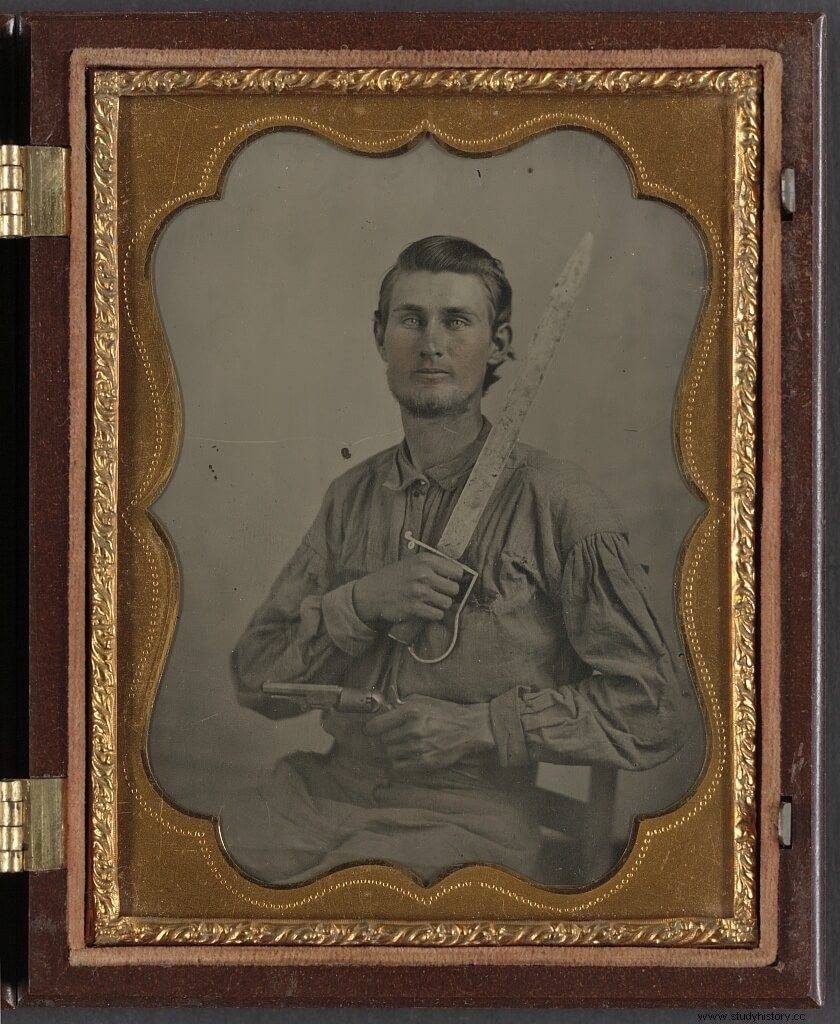
In exploring the reasons for the Confederacy to wage a campaign in New Mexico, the first relevant character is Jefferson Davis, president of the Confederate States of America , who had always been a strong defender of the doctrine of “Manifest Destiny”[1] and, more specifically, of embodying it by occupying the territories west of Texas, not only New Mexico, but also Colorado, Arizona and California. In his opinion, these were poorly defended territories where it might be possible to implant southern culture – with its particular institution, which was the euphemism used by southerners to refer to slavery – and expand cotton cultivation. Another supporter of Texas expansion was John Robert Baylor himself. , the winner of Fort Fillmore, although his argument was not so much social or agricultural, but his main objective was the mining wealth of the territories to be conquered, mainly the gold of Colorado and California, which was ultimately going to be crucial to finance Lincoln's war effort. In addition, it should be noted that, in a much more direct way, what the Confederation was really interested in was taking over the large supply and armament deposits that the regular federal Army had been storing in the border territories, mainly in New Mexico, to fight against Indian tribes, and who could now prove vital to a rebellion whose industrial resources were nowhere near as numerous as their enemy's.
A Confederate chief
Another supporter of expanding the confederacy westward was Henry Hopkins Sibley , from Louisiana. He was a career officer, graduated from West Point in 1838, whose military experience included the Mexican War and various operations against Indian tribes such as the Seminoles in Florida, or the Apaches and Navajos in Texas and New Mexico. He had also participated in the so-called Mormon War and in the bloody pre-secession conflict in Kansas. On May 13, 1861, a month after the bombardment and surrender of Fort Sumter, while stationed at Camp Burgwin near Taos, New Mexico, north of Santa Fe, he resigned his post as an officer in the regular Army—that that same day he had received his promotion to major – to serve the Confederacy. His feelings about it are well reflected in a letter to Colonel Loring, who had been his superior officer until his resignation, and who would later also go on to serve the South.
From Taos, Sibley traveled south along the Rio Grande, passing through Santa Fe and Albuquerque, getting a good idea of the forces and depots present in the region he intended to invade. In Mesilla he had occasion to stop at Fort Fillmore, where he met soldiers from the 7th Infantry Regiment, many of whom he knew and to whom he said, “Guys, if you only knew, I am the worst enemy you have.” [3] It was not true. As already explained, the worst enemies of these men would soon prove to be Commander Lynde, his own boss, and Confederate Lieutenant Colonel John Baylor . After leaving Mesilla, Sibley traveled to El Paso, where he wrote a letter of great importance to Colonel Loring, that of June 12, an excerpt of which has already been quoted above. The relevance of the letter lies in part in the fact that in it he regretted not having acted more crookedly, taking his soldiers with him when he changed sides, and that it announced the arrival of Baylor troops from San Antonio not before July. As has already been said, the actual date was the 15th of that same month.
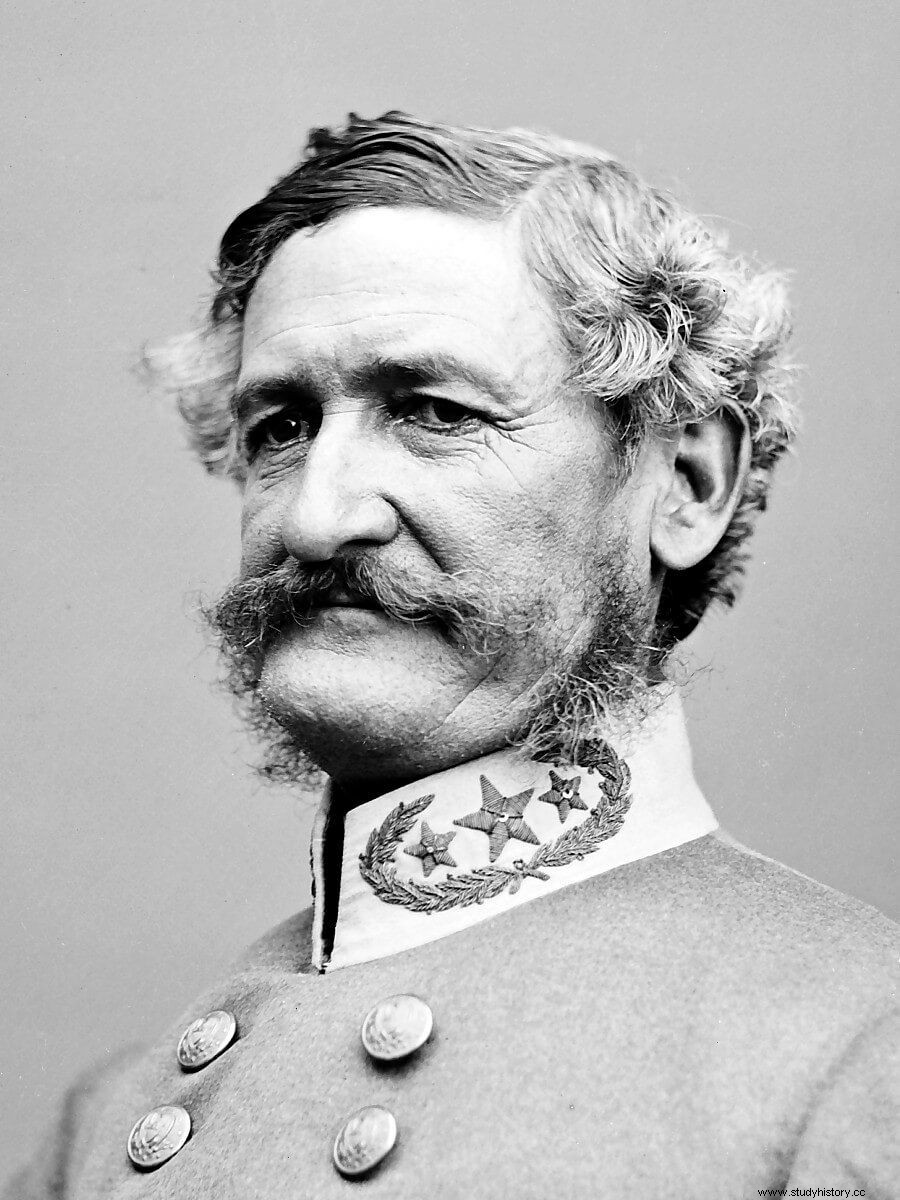
However, the importance of the letter does not lie only in its content, but also in its authentic recipient. When the text arrived in Santa Fe, Loring had already left and the one who read, with astonishment, its content, was Colonel Edward Richard Sprigg Canby , who had replaced the previous one as Commander-in-Chief of the Department of New Mexico. Canby and Sibley had graduated from West Point the same year and had been friends ever since, the former having been best man at the other's wedding, and according to some authors both were related through their wives, who would have been cousins. The first reaction of this officer, who had been promoted in the Mexican War for his bravery in the battle of Churubusco and in the assault on the gate of Belén, in the capital of Mexico, and who had fought alongside Sibley in Florida, Utah and Kansas and against the Navajos the previous winter, he was furious, not because his former comrade-in-arms had decided to join the Confederacy, but because of the betrayal that manifested his regret that he had not taken his soldiers with him. Consequently, Canby wanted to take advantage of the information provided by reading a private letter by sending troops to Fort Fillmore to confront Confederate ambitions. As we have already seen, he was not successful.
Meanwhile, Sibley continued his journey east, passing through San Antonio and New Orleans, arriving in Richmond, where he had occasion to meet personally with Jefferson Davis to discuss the “large amount of Government warehouses, supplies and means of transportation”, adding the possibility of recruiting a squad of committed Texans , equip them with weapons taken from federal armories and forts, and conquer New Mexico with ease.[4] Convinced, the Confederate president entrusted him with the mission of invading New Mexico.
The road to Fort Craig
By mid-August 1861 – a month after the defeat of the Federals at Fort Fillmore and with John Baylor becoming Governor of Confederate Arizona – intense activity had taken hold from San Antonio, Texas, many miles to the west. Men of all stripes mingled in the streets with enthusiastic young men , columns of carts brought various goods to be accumulated in large warehouses, a group of onlookers milled around a small six-pounder shell, no doubt commenting on its strengths and weaknesses, while groups of newly appointed officers took it upon themselves to write down the names of all and distribute them to the regiments that were to march west as soon as possible.
After rising to the rank of Brigadier General in the Confederate Army, Henry Hopkins Sibley had begun organizing the expedition to lead up the Rio Grande to conquer New Mexico and to seize the routes along which the precious minerals traveled, which would serve the war effort of the entire Confederacy. It was not going to be an easy task. Weapons were lacking and many had to equip themselves with shotguns and pistols brought from home, there were hardly any uniforms and, above all, there were no horses. In a frontier society where mount and rider formed an indissoluble unit, each volunteer was expected to bring his own cavalry. In exchange, the Confederation promised to pay the amount of the same, but this would never happen.
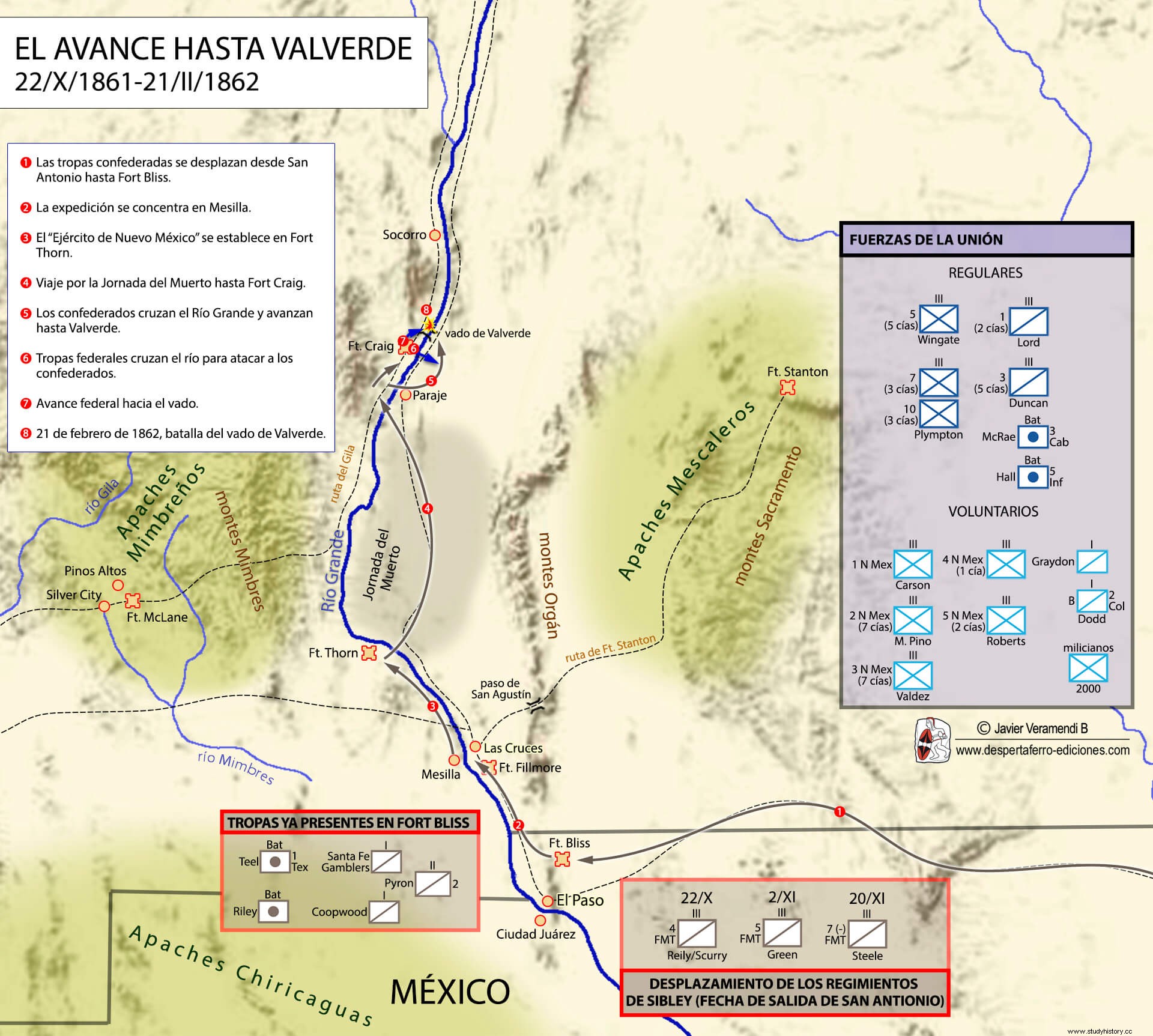
The last challenge prior to the campaign was to move the troops from San Antonio, in central Texas, to El Paso, in the extreme west of the state, crossing a wide semi-desert expanse. The route that linked both locations was the old stagecoach road , initially designed to reach California via Tucson and the Gila River belt. It was a sad and desolate stretch, with few water points, most of which were artesian wells that were slow to refill and could only supply a few men and mounts at a time, not to mention the herds of animals. draft and cattle. To resolve this issue, the Confederate chief decided to send his regiments one by one to the Pecos River , where they would have to divide themselves into squads and companies to cover the remaining route, even more deserted. The first unit to leave was the 4th Texas Mounted Rifle Regiment, which was launched around October 22 to cover the more than 1,000 km that separated the two points. They would not arrive at Fort Bliss until December 17.[5] By then, Sibley, who had been able to travel faster since he was accompanied by a small group, was already waiting for them.
Officially, the campaign began on January 3, 1862 –six months had passed since the destruction of the Fort Fillmore garrison–, when the Army of New Mexico The somewhat excessive name given to Sibley's force, little larger than a brigade, left Mesilla for Fort Thorn, an old abandoned post at the southern end of the "Jornada del Muerto" not far from the present town of Hatch. . In the long column marched the 3. er , 4th, and part of the 7th Texas Mounted Rifle regiments, also known as the 1st, 2nd, and 3rd Sibley's Brigade. Alongside them rode Major Charles L. Pyron's battalion, made up of two companies of the 2nd Texas Mounted Rifles Regiment, hitherto under Governor Baylor's command, and two scout units, spies in the terminology. of the time:the company of Captain Coopwood and the "Santa Fe Gamblers". The latter were a newly formed volunteer company of gunslingers, thieves and bums of all kinds from the Mesilla valley, a group of men whose sole objectives were adventure and plundering the population (especially if they seemed unionist) and who gave themselves the name "Company of the Outlaws", but who despite their dubious origin they would be very useful in the vanguard. Finally, with about a dozen pieces of various types spread over two batteries, Sibley's column was fairly well supplied with artillery, at least in such an out-of-the-way setting. Finally, it is necessary to mention the long column of supplies, which would prove to be the true Achilles' heel of the expedition, and the cattle for food.
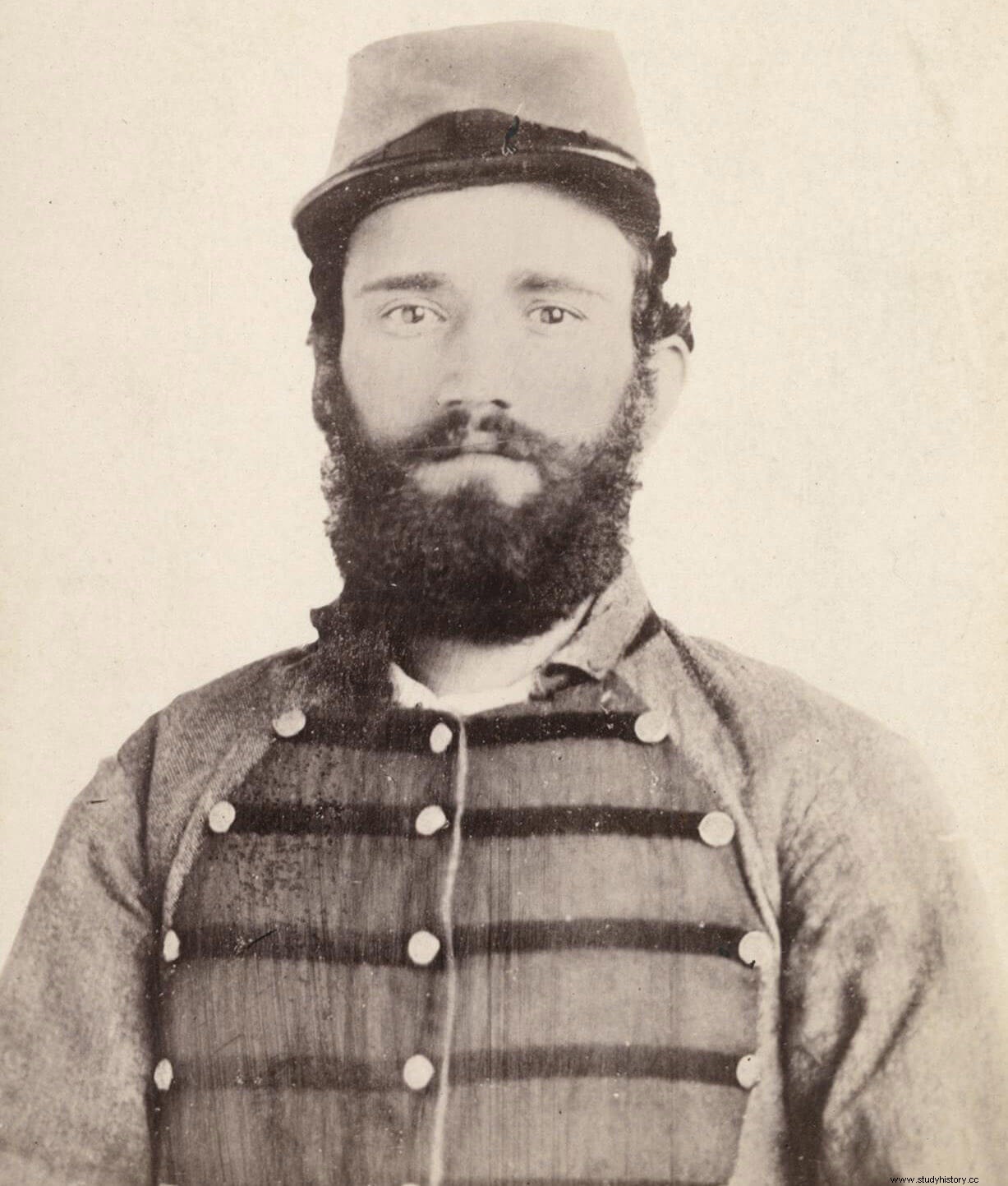
The Fort Thorn stage it lasted until February 7, time to make the final adjustments before marching in search of the enemy. That day an advance guard formed by the 5th Mounted Rifle Regiment and a battery of 6-pounders set out.
After the vanguard followed the rest of the force, whose advance through the Day of the Dead was carried out in small groups, in the same way that they had marched from San Antonio. The desert, harsh in summer, was especially cruel during winter .
The sleet, “fell so hard it could peel the skin off your face.”[7] Six days later, the vanguard camped 20 km south of Fort Craig, under the guard of federal pickets. It was snowing heavily . The next day the main body of Sibley's force arrived and together they made a feint attack which was unsuccessful, so they camped again in the same place as the night before and awaited the arrival of the supply train, which arrived on February 15. That same day, the Army of New Mexico moved one last stretch, to position itself a few kilometers south of the Unionist position. Both forces were finally face to face.
Valverde's move
On February 16, with slightly more benign weather, Sibley decided to send the 5th Texas Mounted Rifle Regiment and Teel's artillery battery to Fort Craig, in order to serve as bait and provoke an exit of the federals that would lead to a generalized battle. Colonel Green, in command of the force, deployed his men some 2,500m south of the Union defenses.
Sheltering in and around Fort Craig, Colonel Edward Sprigg Canby also commanded a sizeable force , but very disparate. On the one hand, he had troops belonging to the 5th, 7th and 10th United States Infantry Regiments and the 1st and 3rd Regular Cavalry; on the other he had the Graydon Company of Scouts and volunteer forces of the New Mexico regiments (2nd and 3rd Infantry and elements of the 4th and 5th Infantry, plus the 1st Cavalry – which despite the domination only had two mounted companies–), the latter considered unreliable, as were the between five hundred and a thousand militia members present. Opinions about these latter combatants contained in the reports are often crude, even disparaging, insisting on their unreliability and tendency to run away, justifying these traits by their Hispanic character. Yet what interest could these men, many of whom had been Mexican until recently, have in fighting the wars of their proud Anglo-Saxon colonizers? Without a doubt, excluding some relevant characters, none. Under these conditions, it is not so surprising that, as soon as the situation became a bit difficult and the treatment was not what they considered appropriate, they simply went home. With regard to artillery, we know of the presence of Hall's and McRae's batteries, totaling eight pieces, but there was certainly more for the defense of the fort itself.
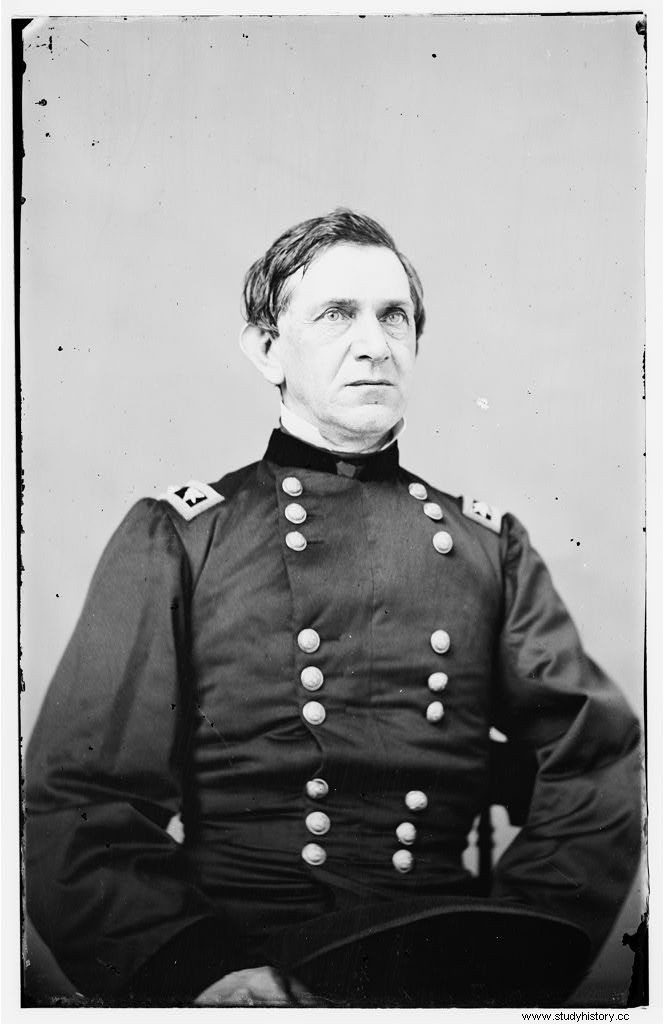
It was precisely the lack of trust in his troops from New Mexico which led Canby to half answer the southern challenge, leaving the fort, but deploying at the foot of its walls, covered by artillery, without going any further. William Davidson, one of the 5th volunteers, would write:
At some point in the process the 4th Texas Mounted Rifle Regiment joined the Southern line, and soon after the Confederates began to retreat. Then the unionists did go into action . Canby sent the Graydon scouts and the two mounted companies of Kit Carson's regiment[9] to pursue the Confederates. Davidson recalls that one federal officer died and six others were wounded in the shooting,[10] however he dates the action to February 18 instead of the 16th, and completely forgets to mention the sandstorm that hit the region on both days. following. Other sources indicate that two New Mexicans could have been injured, one of them fatally.[11] In any case, no one speaks of Confederate casualties and, although there are witnesses who mention having seen crosses where the Texan camp had been during these days, it is impossible to determine the reason for the deaths, which could well have been due to illness.
The consequences of this attempt to engage were perfectly summed up by Sibley:“The reconnaissance demonstrated the futility of assaulting the fort head-on with our light artillery, and that our only chance of success lay in forcing the enemy to fight in the open.”[12] To force this battle he felt his only option was to cross to the other side of the river to go north to Fort Craig where either the Federals would agree to engage or he would cut off their lines of communication and supply. A violent storm raged on the 17th and 18th of February, so the maneuver could not begin until the 19th. By this time, Sibley was ill . It seems that his problem, perhaps a chronic pre-war ailment, first manifested itself in the campaign on February 17, at which point he handed over command of the entire New Mexico Army to Colonel Green, who already had orders. regarding the maneuver he had to carry out, which we will describe later. The general would not intervene in the operations again until the morning of the 21st, during the battle of the ford of Valverde, which he led for a few hours until he fell ill again, at which point he returned command to Green. He would not retake control of the army from him until the next day. However, his poor condition is also attributed to alcohol consumption. One of the southerners described him as “an old army officer whose love for alcohol surpassed his love for his home, his country, or his God”; while Baylor would go much further, saying of him that he was "an infamous coward and a disgrace to the Confederate States", after which he accused him of having escaped to safety in an ambulance with the flag well raised, to prevent the fire enemy fell on him.[13] More ironically, Davidson would describe it:
That said, Sibley's military record was not that of a worthless man, and the fact that he invented a tent for military use and a stove to heat the interior and that both patents were acquired by the US Army shows that he also had a certain ingenuity. Thus, it is not impossible that his excessive alcohol consumption had its reason for being as a palliative for some unknown ailment.
The flanking maneuver started perfectly . On February 19, the Confederates crossed the river near Paraje with no opposition other than the current and the icy water, which reached their waists, and spent the night on the other side, no doubt around large bonfires that, if they had already necessary in the middle of winter, that night, with all the soldiers soaking wet, they must have been vital. The next day, February 20, they began the march towards the northeast, always ascending through volcanic terrain covered with earth and loose rocks, and cut by ridges or deep ravines full of sand that greatly slowed down the pace of the march. That day the progress was not much, pushing the cannons by arm, the Confederates only managed to reach the height of Fort Craig and had to camp in a place without water. It was during this journey that Canby became aware of what was happening, but his first concern was not that his supply route be cut off, but that the Confederates set up their artillery on a rocky plain that rose directly in front of the fort, on the other side. side of the river, in a dominant position to beat it with impunity with their cannons.
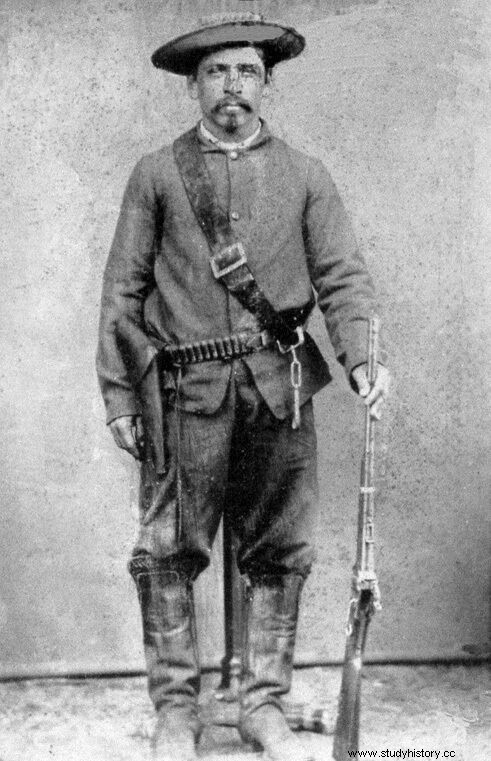
In order to avoid it, late afternoon he sent a force of infantry, cavalry, and artillery across the river to contest those crucial heights from the Confederates. The maneuver could not be carried out in secret and when they were near the top, the feds were able to observe the enemy and hear their band playing Dixie . With the enemy in a dominant position, dug in and waiting, this battlefield was, for the attackers, any tactician's worst nightmare, which was immediately evident when the Confederate guns opened fire from a distance of 800 m. The success was scarce but the resounding success. Two shells exploded near the 2nd New Mexico Volunteer Regiment and two men were wounded, then the unit broke ranks and all the men fled down the hill, dragging their comrades with them.
The dark returned most of the feds back to their fort, but not all. Canby had decided to leave five hundred men on the east bank, including Captain James Graydon, known as "Paddy", who had a plan. Sibley's army, like many others of the day, relied on numerous mule teams to move its cannons and supply wagons, and also brought with it a large herd of oxen to feed the troops, and this adventurer had set out, With the help of some of the men in your scout company, cut off the enemy's resources.
It was nearly midnight when a stealthy group, led by Paddy Graydon, sneaked up on the Confederate camp. Dissimulation was not new in those lands of constant conflict with Apaches, Navajos or Comanches , and therefore it had not been difficult to find a few men who could move in the dark and over unknown terrain without making a sound. They brought with them two mules, undoubtedly the most unlucky of the entire federal Army that night, which they had loaded with 24-pound howitzer grenades. The main problem, for the mules, was undoubtedly not the weight, but the intention of those men:to light the fuses and herd them towards where the enemy's stables and cattle were. The explosions, in the midst of such a concentration of beasts, were undoubtedly going to kill many, injure others – which, given the circumstances, could be counted as dead – and disperse the rest in panic. What Graydon and his men hadn't counted on was that no matter how hard they were herded, as soon as they saw their masters running back toward the river, the stubborn and no doubt malicious mules, instead of lunging at their fellow Confederates, scrambled out. galloping in pursuit of their traitorous masters, starting an intense race against the clock that did not end until the projectiles exploded and the mules were volatilized in all directions , without actually causing casualties among the foolish raiders, who narrowly escaped.[17] After this event, it is ironic that near dawn the thirsty mules of the supply train of the 4th Texas Mounted Rifle Regiment broke their bonds and escaped to drink in the river, where they were captured by the troops left by Canby by the shore. The exact figure, of course, is a matter of debate:"Between two and three hundred horses and mules were captured and brought to the fort," notes Canby,[18] while Sibley refers to "the loss, during the night, by having been carelessly herded, of a hundred mules from the 4th Regiment baggage train.”[19]
The battle of the Ford of Valverde
The encounter that Sibley had longed for finally occurred on February 21, when the vanguard of his column surrounded the Counter Table[20] and descended towards the Valverde ford , where, on the other side of the river, a detachment of federal troops was waiting for her. The fighting that followed lasted from about 9:00 a.m. to 5:00 p.m., when a violent general charge by Confederate troops smashed the Union left wing and seized McRae's battery, whose guns were to become part of the history of the brigade throughout the war under the name of Valverde Battery.[21] Meanwhile, both armies had been feeding the battle with new troops and the result had been in suspense for a long time, with a certain tendency to favor the side of the Union, whose soldiers had managed to cross the river and push the Confederates away from the shore first. , cornering them in a stretch of the old riverbed afterwards and were, at last, preparing a general assault to drive them back into the hills, until they launched the charge that surprised them and disrupted their plans.
During the fighting, the Confederates were weighed down at all times by the limited range of their firearms, mostly shotguns and hunting weapons of various calibers, and even spears captured at the Mexicans during the last war that, however striking, came to be used in combat.
Lieutenant Colonel Scurry, deployed on the Confederate right wing, would also remember the charge:
Interestingly, federal sources are much scarcer, with only Colonel Roberts of the 5th New Mexico Volunteer Regiment mentioning the event when referring to Captain Selden, who “he repelled a determined charge of his spearmen, carried out with audacity and desperation, and became master of the land.”[24]
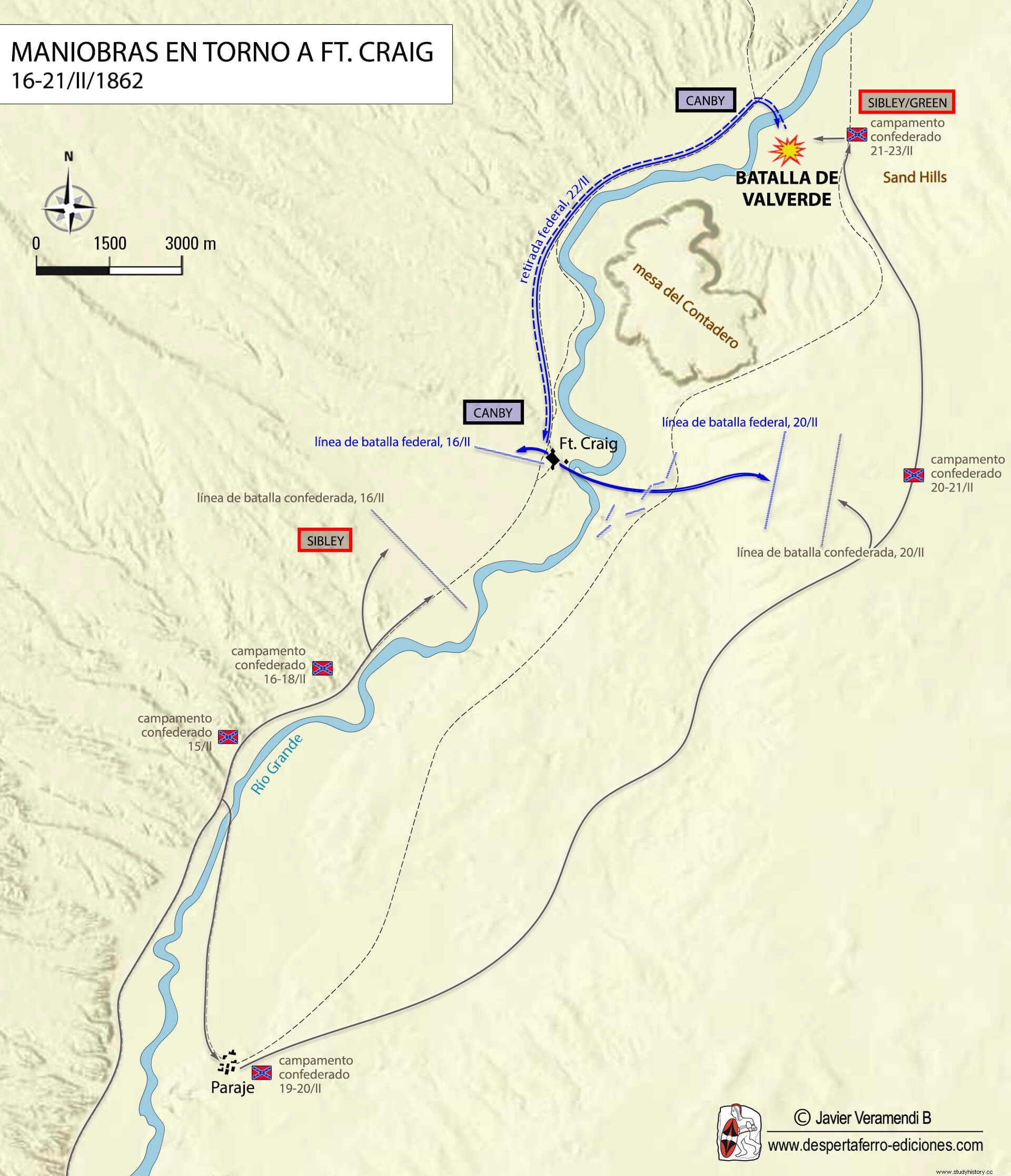
The collapse of the federal left wing led to a full-force withdrawal from Canby, in a more or less haphazard fashion, depending on the units and individual officers' recollections, and a pursuit by Confederate troops that was thwarted when the Union commander-in-chief Very cunningly, he sent an officer with a white flag to ask permission to pick up the wounded. “[…] the white flag of the enemy, in order to request permission to collect their dead and wounded, was hoisted before the sound of the last cannon had finished echoing among the hills”,[25] he would indicate, not without malice, Colonel Green, who had been in command of the Confederate forces after Sibley's relapse, although it seems that Sibley was not entirely out of action, since it was he who ordered that the truce be accepted.
Regarding the white flag, the contradiction between the two reports presented by Colonel Canby is striking, who on February 22 indicated that "under the [white] flag they have withdrawn all the dead and wounded have been removed from the battlefield, and all [public:supplies and weaponry] property has been taken care of.”[26] However, the tone of his second report, made on March 1, is rather more gallant:
Nothing is said in this of the truce flag prank, which no doubt must have embarrassed even him, and it is allowed to imply that his troops fought back to Fort Craig.
Thus ended the first great battle of the campaign, whose casualties were, according to Josephy, made up on the downside by both sides. Thus, Canby would have reported 68 dead, 160 wounded and 35 missing or prisoners; while Green indicated that his side had lost 36 killed, 150 wounded, and 1 missing.[28] 263 against 187 , ridiculous figures by the standards of the great battles fought in other scenarios, but important in armies of around 3,000 men.
The offensive to the north
“Burying the dead and caring for the wounded caused a two-day delay, during which we remained on the battlefield, leaving us with rations for only five days,”[29] Brigadier General Sibley wrote in his May 4 post-campaign report, after which, and with a certain self-justifying tone, he added a brief exposition of his dilemma, very similar to that of any army that would have occupied the rear of the enemy. After the battle, federal troops had taken refuge behind the walls of Fort Craig , south of the ford, so that now the Army of New Mexico cut their lines of communication, however, they neither had the capacity to take their position by assault nor did they have supplies to carry out a siege. In fact, despite being the "besieged", the federals were better supplied than their enemies, who had based the logistics of the campaign on the capture of the opponent's means of subsistence and combat and, therefore, had no more choice but to rush north to Albuquerque and Santa Fe, where the federal depots were, barely protected by meager garrisons. Sibley, who had regained command of the army from him early on the 22nd, called a council of war which agreed on the obvious:march north as quickly as possible, leaving Fort Craig behind. 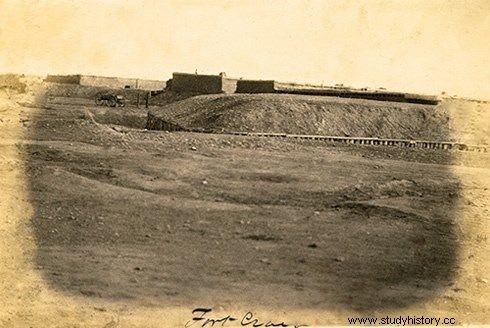
However, before starting the boss The Confederate decided to make one last attempt to solve his dilemma and sent a delegation of officers to request the surrender of the fort and the delivery of the supplies accumulated inside.
The management did not give the desired result and on February 23 the New Mexico Army marched north.
Canby no solo se había negado a rendirse, sino que había tomado una decisión que alargaría la vida de su guarnición a la vez que, esperaba, entorpecería las maniobras del enemigo. En la noche del 22 al 23 de febrero se abrieron las puertas de Fort Craig y, en secreto, una larga columna de tropas compuesta por tropas de voluntarios de Nuevo México abandonó el lugar para rodear el campamento confederado e ir río arriba. Su misión era hostigar al enemigo, pero la mayoría desertó casi de inmediato y volvieron a sus casas. A pesar de todo, no fue un fracaso absoluto. En la tarde del día 24 de febrero un grupo de unos doscientos ochenta hombres se posicionó en la localidad de Socorro, por la que tenían que pasar los hombres de Sibley camino del norte, justo cuando estos se acercaban al lugar. Nada más anochecer, los piquetes de ambas fuerzas entraron en contacto y hubo una breve escaramuza mientras los texanos rodeaban el pueblo, cosa que terminaron de hacer en torno a las 20.00 horas. Entonces empezaron las deserciones entre los nuevomexicanos, y tampoco tuvo éxito el intento de reclutar a los civiles para que se sumaran a la defensa del pueblo:“Don Pedro Baca llegó a decir que el Gobierno de los Estados Unidos era una maldición para este territorio, y que si los texanos se hacían con y conservaban Nuevo México, el cambio solo sería para mejor”.[31] Seguirían diversas reuniones durante la noche, entre ambos contendientes, hasta que los voluntarios de Nuevo México que aún se mantenían en filas, unos ciento cincuenta, se rindieron al ejército confederado y fueron liberados bajo palabra a primera hora del 25 de febrero.
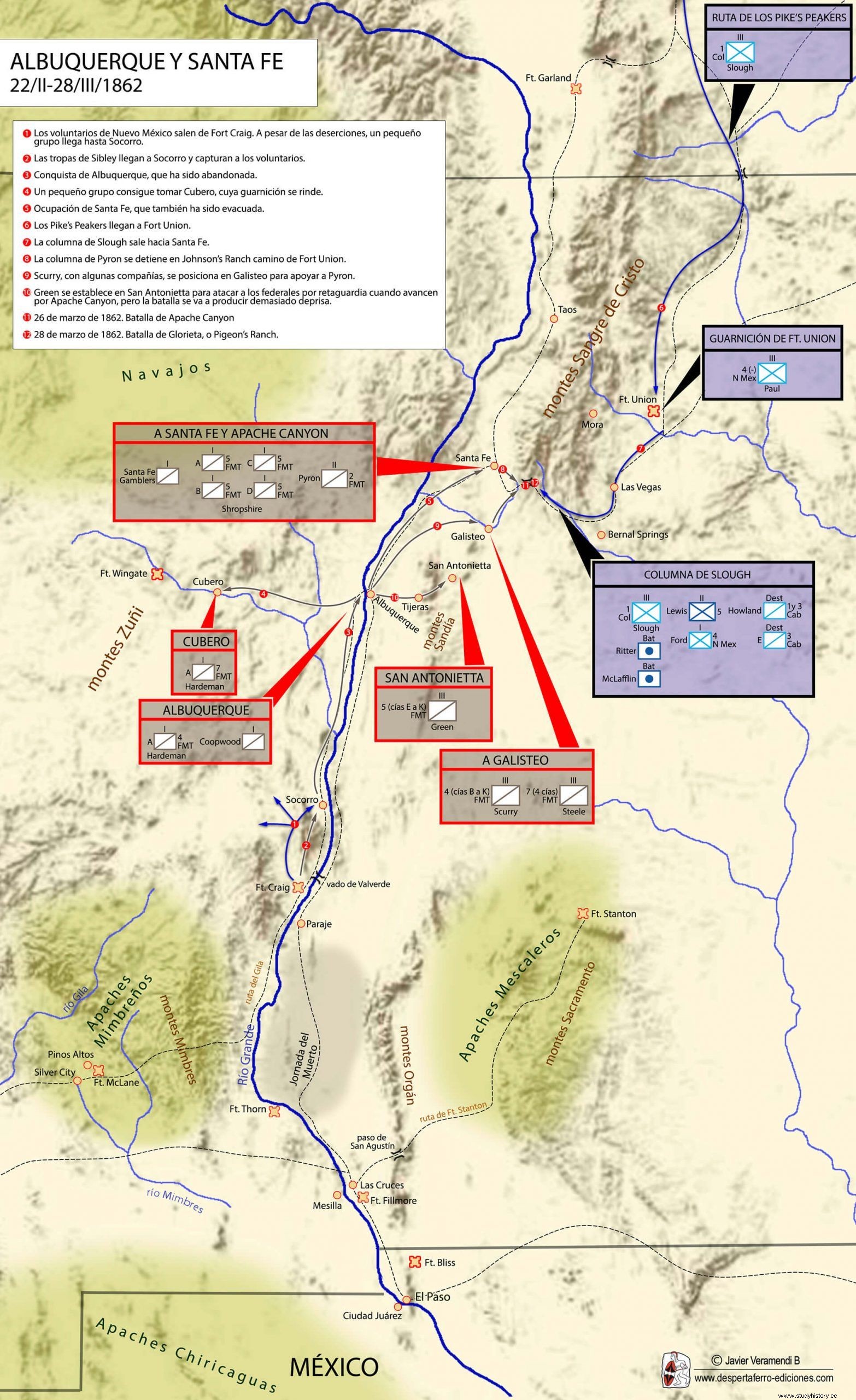
El 2 de marzo de 1862, el Ejército de Nuevo México llegó por fin a la vista de Albuquerque, justo a tiempo para ver cómo densas columnas de humo negro se alzaban de los depósitos en llamas , y escuchar las explosiones de la munición destruida.
La misma escena habría de repetirse en Santa Fe el día 10, donde los confederados encontraron un pueblo desierto y unos almacenes calcinados, pues la mayor parte de las tropas y de los civiles se habían marchado en dirección a Fort Union.
Esto último solo era cierto en parte, porque en realidad los confederados sí que habían conseguido algunos suministros.
A unos 90 km al oeste de Albuquerque, remontando el río Puerco y su afluente el San Juan, se hallaba el puesto de Cubero –en el camino a Fort Wingate, en el centro del territorio Navajo–, donde también había un depósito de suministros, destinado a reabastecer a las tropas que hacían campaña contra dichos indios. A las 9.00 horas del tres de marzo –informaría el capitán Thurmond, que no estuvo presente en la acción, en un informe muy posterior a los acontecimientos–, tras haber cruzado “sin protección, esta peligrosísima porción de territorio indio hostil”,[34] el Dr. F. E. Kavenaugh se personó ante el puesto acompañado de tres hombres más[35], solicitando
Para Davidson,[37] siempre más efectista, la rendición se consiguió gracias a una carga efectuada por tres de aquellos hombres, pero corrobora que el puesto se rindió sin lucha . De hecho, los soldados que lo guarnecían demostraron tener tan poco ardor combativo que se les permitió marchar armados hasta Albuquerque para defenderse de un eventual ataque de los indios, y se confió en que no solo no iban a escapar sino en que allí entregarían las armas intactas antes de ser liberados bajo palabra. Una vez “tomado” el puesto, uno de los aventureros, Gillespie, volvió a Albuquerque para avisar de que se necesitaba una guarnición, y Sibley envió al capitán Thurmond con veinticinco hombres.
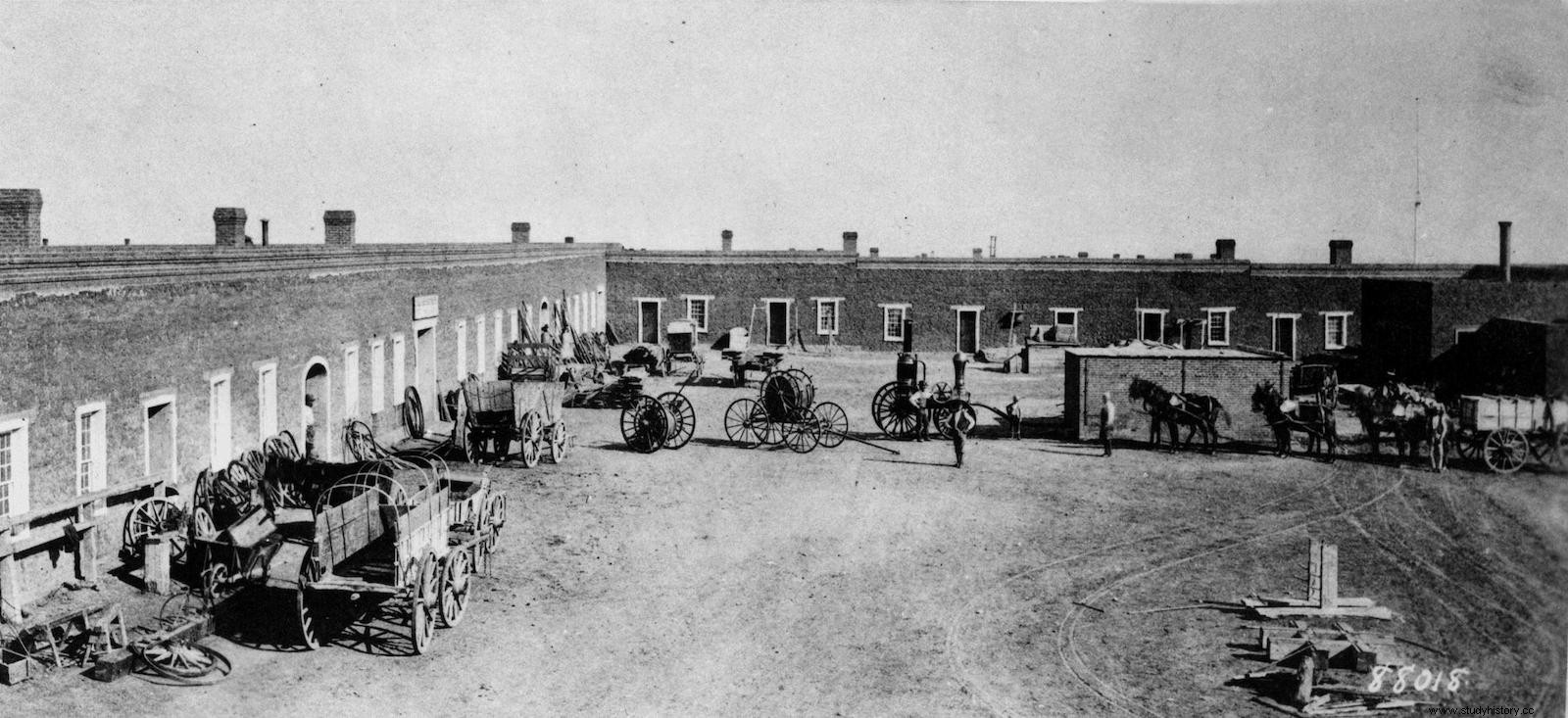
La historia es sorprendente y no indica si aquellos hombres actuaron por su cuenta y riesgo o siguiendo órdenes, aunque en el segundo de los casos lo lógico es que Thurmond y su destacamento los hubieran acompañado desde el principio. Por otro, quien cuenta lo sucedido en un informe es el propio Thurmond, que no se encontraba allí en el momento de la toma del puesto, y aunque Davidson corrobora lo principal, él tampoco estaba allí, por lo que bien pudiera ser que todo el asunto fuera una historia embellecida en los fuegos de campamento. Al final, entre lo capturado en Cubero, lo salvado de los incendios en Santa Fe y Albuquerque, los suministros recuperados forrajeando por los alrededores y confiscando todo los posible a los unionistas, conocidos o presuntos, de la región y la captura fortuita de un tren de carretas destinadas a Fort Craig[38], el Ejército de Nuevo México consiguió acumular suministros para unos cuarenta días, lo que no estaba mal aunque tampoco fuera lo ideal. Entonces, Sibley decidió atacar Fort Union, al oeste de las montañas Sangre de Cristo, sobre la llamada ruta de Santa Fe , un puesto de singular importancia.
Notes
[1] Según la cual, los Estados Unidos estaban destinados “por la autoridad divina” a poseer todos los territorios comprendidos entre su costa atlántica y la del pacífico.
[2] Carta enviada por Sibley desde El Paso, Texas, y fechada el 12 de junio de 1861. War of the Rebellion, a compilation of Official Records , serie 1, volumen IV, p. 55.
[3] Kerby, R. L. (1958):Confederate Invasion of New Mexico and Arizona, 1861-1862 . Los Angeles:Westernlore Press. P. 30.
[4] Thompson, J. (2001):Civil War in the Southwest. Recollections of the Sibley Brigade . College Station:Texas A&M University Press. p XIV.
[5] Por excesivo que pueda parecer, 56 días para recorrer un millar de kilómetros da un ritmo de 16-17 km al día, un ritmo cuyo objetivo era preservar las monturas y que nos da una idea bastante clara de las dificultades de operar tan lejos de las bases propias y por un terreno tan difícil.
[6] Thompson, J. (Ed.) (2001):Civil War in the Southwest. Recollections of the Sibley Brigade. College Station:Texas A&M University Press. p. 19. Se trata del testimonio de W. Davidson, capitán en la compañía A del 5.º Regimiento de Fusileros Montados de Texas, bajo el mando del coronel Green.
[7] La cita pertenece al Journal of Ebeneze Hanna , February 10 to March 27, 1862 . p. 133.
[8] Thompson, p. 23. Testimonio de W. Davidson.
[9] 1.º de Voluntarios de Nuevo México
[10] Thompson, p. 23. Testimonio de W. Davidson.
[11] Josephy, A. M. Jr. (1991):The Civil War in the American West. New York:Vintage Books. p. 65.
[12] Informe del general de brigada H. H. Sibley, redactado en Fort Bliss, Texas, y fechado el 4 de mayo de 1862 (después de toda la campaña). War of the Rebellion, a compilation of Official Records , serie 1, volumen IX, p. 507.
[13] Josephy, pp. 69-70.
[14] En referencia a una canción popular en la que este personaje representa a la cosecha de cereal, y las bebidas alcohólicas que se producen con ella.
[15] Thompson, p. 6. Testimonio de W. Davidson.
[16] Informe del coronel Edward R. S. Canby, del 19.º de Infantería, al mando del Departamento de Nuevo México, redactado en Fort Craig el 1 de marzo de 1862. War of the Rebellion, a compilation of Official Records , serie 1, volumen IX, p. 489.
[17] Josephy, p 67.
[18] Informe del coronel Edward R. S. Canby del 1 de marzo. War of the Rebellion, a compilation of Official Records , serie 1, volumen IX, p. 489.
[19] Informe del general de brigada H. H. Sibley del 4 de mayo. War of the Rebellion, a compilation of Official Records , serie 1, volumen IX, p. 508.
[20] También conocida como Table Mesa o Black Mesa, estaba situada en la orilla este del río, justo un poco más al norte de Fort Craig.
[21] Compuesta por un obús de montaña de 12 libras, dos obuses de 12 libras y tres cañones de 6 libras.
[22] Thompson, p. 47. Testimonio de W. Davidson.
[23] Informe del teniente coronel W. R. Scurry, del 4.º Regimiento de Voluntarios Montados de Texas, redactado en Valverde, al día siguiente de la batalla. War of the Rebellion, a compilation of Official Records , serie 1, volumen IX, p. 514.
[24] Informe del coronel B. S. Roberts, 5.º Regimiento de Voluntarios de Nuevo México, redactado en Fort Craig el 23 de febrero de 1862. War of the Rebellion, a compilation of Official Records , serie 1, volumen IX, p. 495.
[25] Informe del coronel Thomas Green, del 5.º Regimiento de Fusileros Montados de Texas, redactado en el campamento de Valverde al día siguiente de la batalla. War of the Rebellion, a compilation of Official Records , serie 1, volumen IX, p. 421.
[26] Informe del coronel Edward R. S. Canby, del 19.º de Infantería, al mando del Departamento de Nuevo México, redactado en Fort Craig el 22 de febrero de 1862, día siguiente a la batalla. War of the Rebellion, a compilation of Official Records , serie 1, volumen IX, p. 487.
[27] Informe del coronel Edward R. S. Canby, del 19.º de Infantería, al mando del Departamento de Nuevo México, redactado en Fort Craig el 1 de marzo de 1862. War of the Rebellion, a compilation of Official Records , serie 1, volumen IX, p. 491.
[28] Josephy, p 73.
[29] Informe del general de brigada H. H. Sibley del 4 de mayo. War of the Rebellion, a compilation of Official Records , serie 1, volumen IX, p. 508.
[30] Informe del coronel Edward R. S. Canby, del 19.º de Infantería, al mando del Departamento de Nuevo México, redactado en Fort Craig el 1 de marzo de 1862. War of the Rebellion, a compilation of Official Records , serie 1, volumen IX, p. 492.
[31] Informe de Charles Emil Wesche, comandante en el 2.º Regimiento de Milicia de Nuevo México, redactado en Santa Fe el 5 de mayo de 1862. War of the Rebellion, a compilation of Official Records , serie 1, volumen IX, p. 605. El informe, bastante completo, narra todos lo acontecido en Socorro desde el punto de vista del mando.
[32] Informe del comandante J. L. Donaldson, al mando del Distrito de Santa Fe, redactado en Fort Union el 10 de marzo de 1862. War of the Rebellion, a compilation of Official Records , serie 1, volumen IX, p. 527.
[33] Ibíd.
[34] Informe del capitán A. S. Thurmond, 3. er Regimiento de la Brigada de Sibley [también conocido como el 7.º Regimiento de Fusileros Montados de Texas], firmado en Cubero el 19 de marzo de 1862. War of the Rebellion, a compilation of Official Records , serie 1, volumen IX, p. 529.
[35] Si bien el informe del capitán Thurmond dice que fueron “el Dr. F. E. Kavenaught al mando de tres americanos”, que más adelante identifica como los señores Thompson, Gillespie y Gardenhier; Davidson solo cita tres nombres:el doctor [Finis E.] Kavanaugh, [Richard] Dick Gillespie y un holandés [George Gardenhier].
[36] Informe del capitán A. S. Thurmond, War of the Rebellion, a compilation of Official Records , serie 1, volumen IX, p. 528.
[37] Thompson, p. 79. Testimonio de W. Davidson.
[38] Josephy, p. 75
[39] Carta del coronel Edward R. S. Canby al coronel G. R. Paul de fecha 16 de marzo de 1862, recibida el 21. War of the Rebellion, a compilation of Official Records , serie 1, volumen IX, p. 653.
